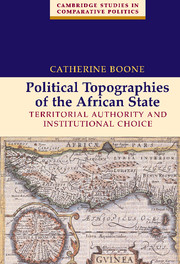Book contents
- Frontmatter
- Contents
- List of Maps, Tables, and Figures
- Preface and Acknowledgments
- 1 INTRODUCTION
- 2 MAPPING POLITICAL TOPOGRAPHY IN AFRICA
- 3 UNEVEN INSTITUTIONAL TOPOGRAPHY WITHIN ONE STATE
- 4 TAXING RICH PEASANTS: REGIME IDEOLOGY AS STRATEGY
- 5 THE GEOPOLITICS OF LATE DEVELOPMENT
- 6 CONCLUSION
- Appendix: A Note on Sources, Evidence, and Measurement
- References
- Index
- Cambridge Studies in Comparative Politics
Appendix: A Note on Sources, Evidence, and Measurement
Published online by Cambridge University Press: 26 December 2009
- Frontmatter
- Contents
- List of Maps, Tables, and Figures
- Preface and Acknowledgments
- 1 INTRODUCTION
- 2 MAPPING POLITICAL TOPOGRAPHY IN AFRICA
- 3 UNEVEN INSTITUTIONAL TOPOGRAPHY WITHIN ONE STATE
- 4 TAXING RICH PEASANTS: REGIME IDEOLOGY AS STRATEGY
- 5 THE GEOPOLITICS OF LATE DEVELOPMENT
- 6 CONCLUSION
- Appendix: A Note on Sources, Evidence, and Measurement
- References
- Index
- Cambridge Studies in Comparative Politics
Summary
Data and Sources
Data for this study were gathered in the course of my comparative studies of political control over rural and urban marketing circuits in Senegal and Côte d'Ivoire (Boone 1992, 1993, 1995a). Between 1984 and the mid-1990s I did field work, concentrating mostly on documentary sources, archival sources, and interviews in Côte d'Ivoire and Senegal (Abengourou, Korhogo, Man, Abidjan, Dakar, Thies, Saint-Louis, and Ziguinchor). Research was funded by grants from the Social Science Research Council, Fulbright, the McNamara scholarship of the World Bank Development Institute, and the Harvard Academy of International and Area Studies.
The present analysis expanded upon this work through a study of a wide variety of primary and secondary sources dealing with the countries concerned for the period from 1930 to 2000. Sources included studies by colonial administrators, anthropologists, historians, geographers, political scientists, and agricultural economists, and local-level studies of rural administration, development administration, electoral politics, migration patterns, and land tenure use. Valuable analyses were also written by university students in each of the countries studied, government agencies in all three countries, government-funded research institutes, aid-agency and nongovernmental-organization (NGO) monitoring teams, etc.
Many “gray” documents – unpublished studies, theses and dissertations, conference papers, and reports from governmental, nongovernmental, and academic sources – provided critical pieces of this study.
- Type
- Chapter
- Information
- Political Topographies of the African StateTerritorial Authority and Institutional Choice, pp. 353 - 358Publisher: Cambridge University PressPrint publication year: 2003

